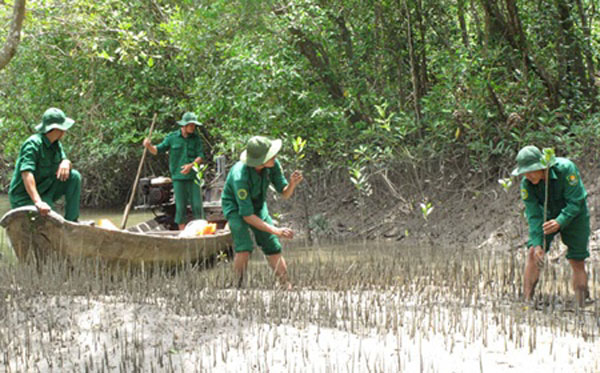MAP News Issue 345 – August 16, 2014
Partnering with mangrove forest communities, grassroots NGOs, researchers and local governments to conserve and restore mangrove forests and related coastal ecosystems, while promoting community-based, sustainable management of coastal resources. | |
The MAP News | |
Action Alerts: Your Century! Event Information | FEATURED STORY Mangrovia Joins MAP’s Marvellous Mangroves August 2014  USA – 2014 has so far been a busy year for MAP’s Marvellous Mangroves curriculum -‐ perhaps one of our busiest. Beginning in January Education Director Martin Keeley visited Kenya where initial work has started on translating into Swahili and adapting Marvellous Mangroves for schools in that country. Later that month he visited Freeport, Bahamas, where students and teachers enjoyed a two-‐day workshop. Meanwhile, MAP associate Mafruza Khan joined students and members of CLEAN Khulna in the Sundarbans to conduct a trial run of various activities. Work continues in Khulna on translation to Bangla as well as adaptation to local flora and fauna, and teacher workshops are planned for early 2015. The summer has been exceptionally busy. It started with a joint workshop held in South Sulawesi, Indonesia, with co-‐sponsors Blue Forests. Founder Ben Brown organised the translation and adaptation of Marvellous Mangroves for use in Indonesia, and it was launched at a 3-‐day teachers’ workshop at PPLH Puntondo, Takala, South Sulawesi with 30 teachers attending as well as a surprise afternoon visit from 15 schoolchildren (grades 5-7). READ MORE AFRICA Mangrove Forests Under Siege of Illegal Human Activities  TANZANIA – Mangroves grow along coastal areas in deltas where cold water river enters the ocean. Tanzania is one of few countries which have been blessed with mangrove forests, with an estimated 115,000 total hectares of the trees. According to scientists, there are about nine species of mangroves in the country. Variations of species and their location are the key factors which determine the growth and size. The trees produce their own natural treatment that protects them against all types of insects and other harmful organisms. The trees offer a number of benefits, one being protecting beaches and coastal areas against storms. The importance of mangrove forests was evident during Tsunami catastrophe in 2004 in Southern Asia, where areas which had mangrove forests were less affected compared to those with bare beaches. For quite a number of years, the trees have been hunted as they are sold at higher prices in local and international market due to their high quality. The trees are mostly sought for construction especially in tourist hotels. They are also wanted for boat making, charcoal, furniture and building houses. READ MORE ASIA Mangrove loss, dredging blamed in Holiday deaths  PAKISTAN – The death toll from the Eid holiday drowning tragedy rose to 34 after 11 more bodies were recovered from the Arabian Sea. Political parties called for an independent inquiry into the incident which, according to a fisherfolk organization, occurred mainly because of growing human intervention in the sea by the DHA and port authorities. Pakistan Fisherfolk Forum (PFF) chairman Mohammed Ali Shah said three factors had made the Karachi beach a dangerous point. First, mangroves on the coastal area have been cut. This has intensified tidal waves. Second, dredging activity by the port authorities and reclaiming of lands by the DHA have increased. The PFF chief believed that there should be no commercial activities in an area within 500 metres from the beach. Third, police and the administration have failed to make security and other arrangements, especially during holidays and weekends. READ MORE Sunderbans Mangrove Trees Losing Capacity to Absorb CO2 BANGLADESH – The vast mangrove forest in the Sunderbans is fast losing its capacity to absorb carbon dioxide, one of the main greenhouse gases, from the atmosphere due to rise in the salinity of water, rampant deforestation and pollution, a study has found. The mangrove forest, marsh grass, phytoplanktons, molluscus and other coastal vegetation in the world's largest delta are the natural absorbers of carbon dioxide (CO2), according to the study. The stored carbon in the plants is known as "Blue Carbons". The absorption of CO2 is a process which contributes to reduction of the warming of the earth and other ill effects of climate change. The research study, "Blue Carbon Estimation in Coastal Zone of Eastern India – Sunderbans", was financed by the Union government and headed by noted marine scientist Abhijit Mitra. The report took three years to prepare and it was submitted to the government last year. READ MORE Report says mangrove cover unchanged for nine years, activists aghast INDIA – Maharashtra's mangrove cover has remained unchanged at 186 sq km for nearly a decade, according to an environment ministry report that was questioned by activists and forest officials alike. Titled India State of Forest Report 2013, the report has been prepared by the Dehradun-based Forest Survey of India by using remote sensing data. It says that India's mangrove cover measures 4,628 sq km or 0.14% of the total area; "compared with the 2011 assessment, there has been a net decrease of 34 sq km." The drop has been noted in West Bengal on account of exclusion of creeks and in Gujarat. READ MORE German help for proposed mangrove sanctuary in Airoli INDIA – The state forest department has tied up with a German government agency, GIZ, to create a marine interpretation centre (MIC) along the Airoli coast of the Thane creek. A unique urban mangrove sanctuary for the public to enjoy open wetland spaces is to be created by the centre. The MIC is expected to be ready by next year. "MIC will be akin to the Nehru Science Centre in Worli; only, it will be on a grander scale covering the northern tip of Thane creek, and dealing with environmental science and wetlands," chief conservator of forests (mangroves cell) N Vasudevan said on Monday. "It can be an ideal place for students and the public at large who want to know and enjoy nature." READ MORE Mangrove forest conservation measures proposed  VIETNAM – Mangrove forests develop in shallow water, such as in gulfs and estuaries sheltered by capes, narrow straits or along coasts protected by archipelagos. Although they account for a small part of Viet Nam's forests, they provide an important role in the preservation and protection of coastal and estuarine regions, habitat provision, storm protection, erosion control and carbon sequestration, said Phan Huy Thong, director of the National Agriculture Extension Centre. Mangrove forests are present in 20 provinces and cities in the country, mostly in the south, and have diverse species, Thong told participants at a forum organised by the centre and the Ca Mau Province Department of Agriculture and Rural Development. Mangroves in 1943 covered 408,500ha but due to aquaculture and urban development, the country has lost nearly 60 per cent of its mangrove forest over the last 70 years, to only 166,000ha now, he said. "Coastal erosion and higher levels of sea water caused by climate change have contributed to mangrove forest reduction," said Nhu Van Ky, an expert of the Viet Nam Administration of Forestry's Department of Forest Development. READ MORE AMERICAS Mangroves already on the move in Southwest Florida  USA – The spidery-looking mangroves stretch about 60 feet from the seawall guarding Centennial Park in downtown Fort Myers, Florida. The plants separate the park from the Caloosahatchee River and provide welcome greenery. But they have nowhere to move, which means they're doomed to drown in the next hundred years due to sea level rise. In the past, mangroves have dealt with sea level rise and fall through their ability to migrate and "build land" around them. However, as the rate of sea level rise accelerated during the 20th century, mangroves became less effective at building land, said Kevin Cunniff, research coordinator for Rookery Bay National Estuarine Research Reserve in an emailed response to The News-Press. The issue for many of Southwest Florida's mangroves is a lack of space. Coastal development and erosion control structures like the seawall at Centennial Park prevent the trees from migrating away from the rising seas. READ MORE Fishermen plant mangroves Not yet a subscriber? Click here to subscribe. Please cut and paste these news alerts/ action alerts on to your own lists and contacts. Help us spread the word and further generate letters of concern, as this can make a big difference in helping to halt a wrongdoing or encourage correct action.
|
| Mangrove Action Project | |




